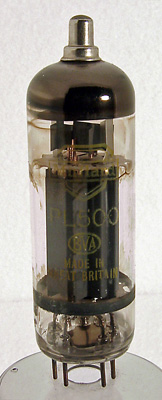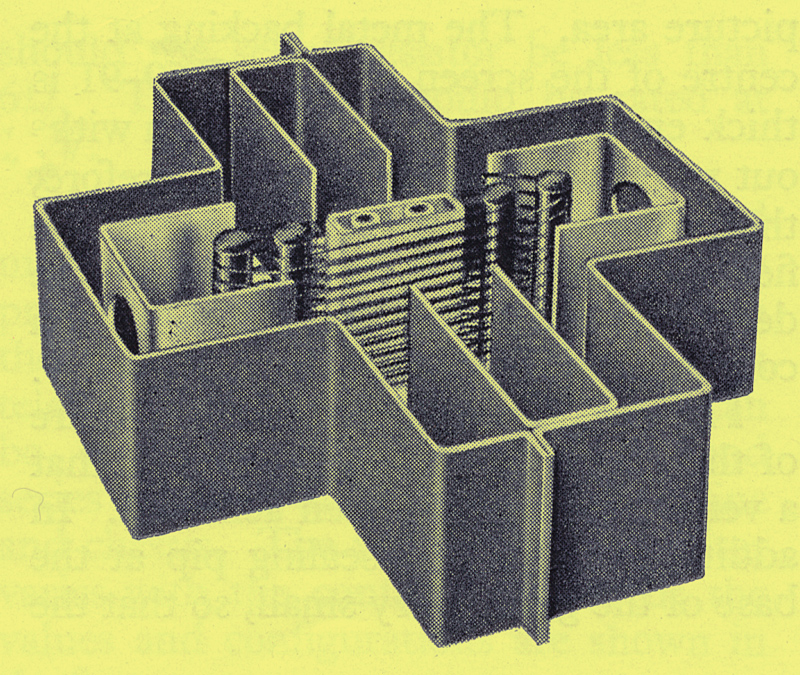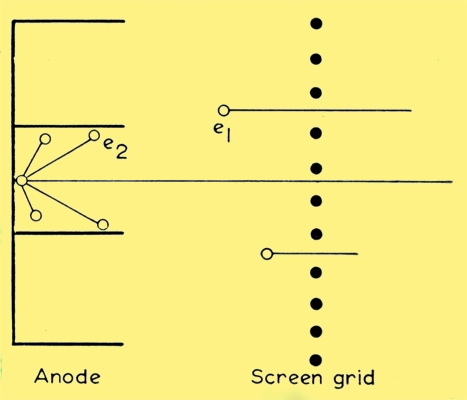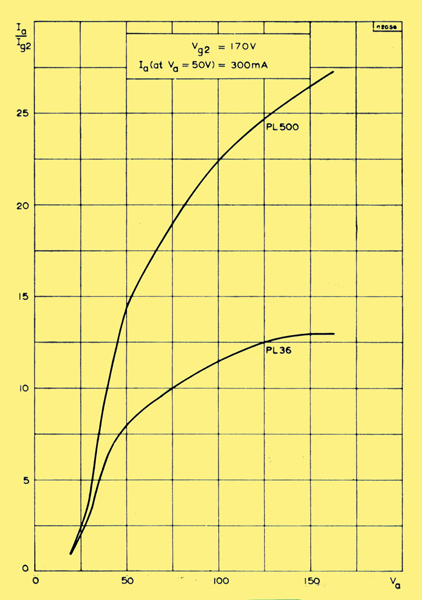|

The Mullard PL500.
In dual-standard television receivers it is important that the performance of the line timebase does not deteriorate when the receiver is switched between line standards, since most functions of the line timebase are critical. Any deterioration in line timebase performance is noticeable and would affect viewing. Consistency in performance must therefore be achieved despite the fact that the energy requirements for 625-line operation are roughly one and a half times as great as those of 405-line operation. The task of obtaining comparable performance in dual-standard receivers can be simplified by the use of the new Mullard line output pentode, type PL500. With this valve it is possible to obtain a high anode peak current.
Anode to Screen Grid Current Ratio
Since screen-grid current represents wasted energy, it is desirable that it be kept to a minimum in all pentodes and thus allow a high ratio of anode to screen-grid current to be produced. This is particularly true of line output valves Working at low anode voltages.
The factors which govern screen-grid current are:
- primary electrons from the cathode which directly strike the screen grid;
- electrons reflected from the anode to the screen grid;
- secondary-emission electrons from the anode to the screen grid: these are produced by the impact of primary electrons from the cathode on the anode.
Several methods have been employed to reduce these sources of screen-grid current including the shadowing of the control-grid and screen-grid wires and coating the anode with materials having a low secondary emission coefficient. These methods did produce some reduction but a considerable amount of screen-grid current still remained because of factors (ii) and (iii) concerning secondary electrons, and further reduction was desirable. This reduction has been achieved in the Mullard PL500 valve.
The Cavitrap Anode

The Cavitrap anode of the PL500.
The PL500 valve incorporates the most advanced anode design in vacuum tube technology - the 'cavitrap' anode. The purpose of the cavitrap design is to reduce secondary-emission electrons to a minimum. This anode is similar to a standard anode except that it is partitioned by vertical walls which run at right angles to the anode and form cavities. The design and structure of the cavitrap is illustrated above. The manner in which the cavitrap anode operates to reduce screen-grid current due to secondary electrons is illustrated below.

Suppression of secondary-emission electrons.
As the name implies, the cavitrap anode traps the majority of the secondary electrons along the walls of the cavities. Secondary electrons e2 are either reflected primary electrons e1 or secondary-emission electrons ejected from the anode by the impact of the primary electrons. In the operation of a valve using a standard anode these secondary electrons would be attracted to the screen grid. In the cavitrap design, however, the majority of the secondary electrons are trapped along the cavity walls and are thus prevented from being sources of screen-grid current.
Performance of the PL500

Ratio of anode to screen-grid currents as a function of anode voltages.
The illustration above shows the improved ratio of anode to screen-grid current which the PL500 has over that of its predecessor, the PL36. Moreover, although the PL500 has the same bulb dimensions as the PL36, in practical circuits it is capable of delivering 40% greater deflection energy than the PL36 under the same operating conditions. The improved ratings of the PL500 thus simplify the design of the line timebase for the more stringent requirements of dual-standard receivers.
Magnoval Base
In addition to the different anode design, the PL500 also features a new base construction. This base is known as the B9D or magnoval base and is an all-glass construction which is fitted with nine sealed-in pins. The glass base eliminates the risk of poor insulation between the pins.
|